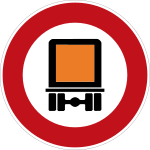Tunnel restriction code
The tunnel restriction code in the European Agreement on the International Carriage of Dangerous Goods by Road (ADR) regulates which dangerous goods are allowed to pass through a tunnel .
Part of the ADR
The tunnel restriction code has been part of the ADR 2007 and can be found under Chapter 8.6. In addition, a tunnel restriction code is assigned to each substance in Chapter 3.2 (Table A) of the ADR . There it is in column 15 of the table, in brackets, under the respective transport category.
Purpose of the tunnel restriction code (TBC)
The tunnel restriction code was introduced after some dangerous accidents with the transport of dangerous goods in tunnels (e.g. in the Tauern tunnel ). Tunnels are classified into a total of five categories (A – E) and restricted by the prohibition sign 261 of the StVO .
- See also: Tunnel technology , examples of tunnel safety
Tunnel category
In general, the higher the tunnel category , the stricter the restriction on transported goods. The restriction class is indicated for all categories except A by an additional sign to the prohibition sign 261 .
| A. | no restriction on dangerous goods |
| B. | No passage with dangerous goods that can lead to a very large explosion |
| C. | same restriction as for B plus dangerous goods which can lead to a major explosion or extensive release of toxic substances |
| D. | C corresponds to additional dangerous goods that can lead to a major fire |
| E. | No passage for all dangerous goods, with the exception of UN2919 , UN3291 and UN3373 (certain radioactive substances, clinical waste and materials) |
Tunnel restriction code levels
| TBC of the total charge | restriction |
|---|---|
| B. | Passage forbidden through tunnels of cat. B, C, D and E |
| B1000C |
|
| B / D | When transported in tanks, passage through tunnels of cat. B and C, otherwise D and E is prohibited. |
| B / E | When transporting in tanks, passage through tunnels of category B, C and D, otherwise tunnels of category E is prohibited |
| C. | Passage forbidden through tunnels of cat. C, D and E |
| C5000D | Transport of a total net explosive mass per transport unit
|
| CD |
|
| C / E |
|
| D. | Passage forbidden through tunnels cat. D and E |
| D / E |
|
| E. | Passage forbidden through tunnels of Cat. E |
| - | Passage through all tunnels is permitted (for UN numbers 2919 and 3331 see also subsection 8.6.3.1) |
swell
- ↑ European Agreement concerning the International Carriage of Dangerous Goods by Road - ADR 2011; Chapter 8.6; Road tunnel restrictions for the passage of vehicles with dangerous goods

